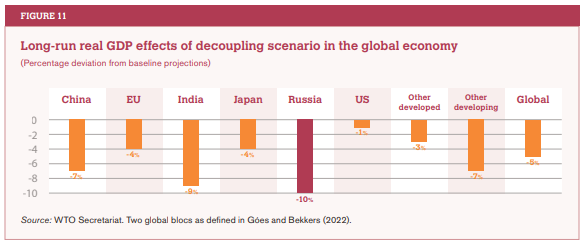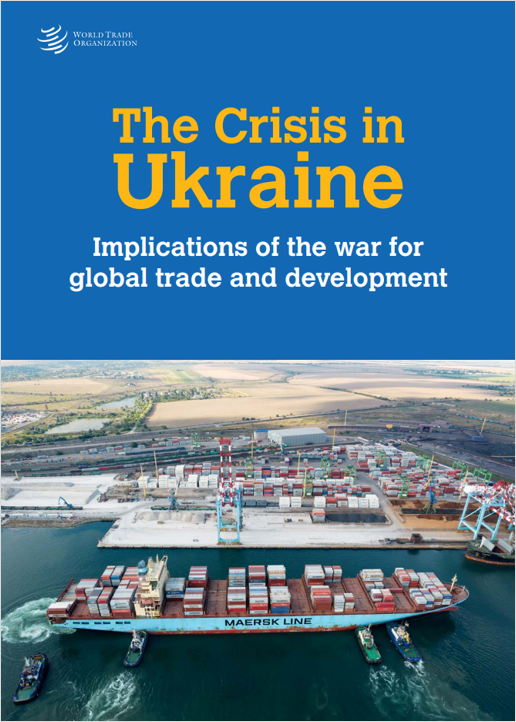How to use it
The crisis in Ukraine: Implications of the war for global trade and development
Published 26 July 2022
Russia’s invasion of Ukraine is a devastating event for Ukraine and the world. Many analysts and economists are examining the impact of the war on the global economy. In this report, published in April 2022, the World Trade Organization (WTO) Secretariat applies its unique analytical capabilities and provides a useful resource contributing for ongoing discussions and debate.
Here’s how to use the report entitled The Crisis in Ukraine: Implications of the war for global trade and development.
Why the report matters
Russia and Ukraine are critical suppliers of essential resources in global supply chains. Russia’s invasion has crippled Ukraine’s economy and retaliatory sanctions have closed transport corridors. Already-stressed global supply chains are adversely impacting global GDP and trade growth. Supplies of key foodstuffs and energy resources are at risk. The gravity of the situation threatens to further reduce supplies and increase prices in the developing world, causing food and energy insecurity.
By providing this analysis, the WTO is helping economies brace for challenges to come. The report also identifies the products at highest risk from high prices and disruption, and the opportunities to work with other economies in finding substitute sources (Table 1, p. 12).
What’s in the report
The report contains two key sections:
- An assessment of the trade and economic effects of the war by trading partner, region, and product, as well as of the economic impact of sanctions on Russia. This section provides useful baseline information that policymakers and analysts can refer to in their own work.
- A five-scenario analysis of the projected income and trade effects of the war. This section provides estimates of the war’s potential impact on the global economy and those who are most vulnerable. The estimates enable policymakers to prepare for and mitigate severe outcomes.
In addition, the report addresses the role of the multilateral system in alleviating the war’s economic impact, and recommendations for governments around the world.
How to find the insights
The report’s key insights are illustrated by compelling data and clear visual aids. We distinguish the insights into the following categories:
Economic impact | Regional and sectoral impact | Geopolitical impact | Role of multilateral institutions
Economic impact
- 2022 global GDP growth may be reduced by up to 1.3 percent, to between 3.1 to 3.7 percent, depending on the impact of five assessed scenarios:
- Direct effects of the war on Ukraine's economy
- Impact of different sanctions on Russia and on the sanctioning economies
- Reduction in aggregate demand and falling consumers and business confidence globally
- Food export restrictions and release of food stockpiles
- Formation of economic blocs and decoupling between the two). (Table 2, p. 17; Figure 6, p. 18).
- 2022 global trade growth may be half of initial projections, down from 4.7 percent projected in October 2021 to 2.4 to 3 percent projected in April 2022. Longer term impacts could also be large and consequential.
- European economies will bear the brunt of the crisis, as they compose the largest export markets for Russian and Ukrainian goods. (Figures 1 and 2, p. 5; Figure 5, pp. 10-11).
- Ukraine will lose the most in terms of GDP, while Russia will most feel the impact of sanctions; developing economies will bear negative indirect effects (Figure 7, p. 19; Figures 9-11, p. 21).
Regional and sectoral impact
- Africa and the Middle East are the most vulnerable regions, with Russia and Ukraine supplying half of their grain imports. (Figure 3, p. 6; Figure 5, pp. 10-11; Figure 9, p. 21).
- Higher prices for food and energy will reduce real incomes and depress global import demand, in particular affecting food security in poor regions. Export restrictions will exacerbate this trend. (pp. 6-8; Figure 10, p. 21).
- Russia and Ukraine provide key manufacturing inputs like steel, iron, palladium, rhodium, and neon and krypton gases; in some cases large shares for key manufacturing countries. Disruptions in these supplies may have an impact on automotive and semiconductor production, among other industries. (Figure 4, p. 9; Figure 5, pp. 10-11).
- Russia and Ukraine are the world’s major suppliers for rhodium and crude sunflower oil. In the short run, the war’s disruptions are likely to cause major bottlenecks in supply chains that rely on these inputs.
- The war and the breakup of longstanding economic relations may lead more economies to “decouple” based on geopolitical considerations, which could reduce global GDP in the long run by about 5 percent, and result in less competition and innovation in the long run. (Figure 11, p. 21).
 Extracted from : The Crisis in Ukraine: Implications of the war for global trade and development by WTO Secretariat
Extracted from : The Crisis in Ukraine: Implications of the war for global trade and development by WTO Secretariat
- The WTO plays a key role in maintaining trade flows during times of crisis, due to its ability to monitor and provide transparency over trade restrictions.
- Multilateral institutions like the WTO can help to mitigate the negative effects of the crisis and rebuild the post-war global economy, by providing a forum where countries can convene, build trust, and negotiate. They can assist in ensuring transparency, cooperation, and coordination globally.
- Globalized supply chains provide a form of resiliency. Governments should avoid restricting trade, especially by adopting export restrictions and choosing to concentrate and source production domestically.
Conclusion
In this report, the WTO Secretariat helps to shape an ongoing, critical conversation about the impact of Russia’s invasion of Ukraine, by providing key, trade data and clearly presenting a useful estimation of the likely impact of the war, based on five scenarios. This information and analysis gives policymakers clear data points to help them make the best possible policy choices in response to an extremely challenging situation.
***
Complementary reports and analysis
Hinrich Foundation
- Stepping on the gas: the Ukraine war reshapes climate and energy policy
- China will gain economically from the Ukraine war. What might it lose?
- Mercantilist reciprocity or free trade: Globalization at a crossroads
External Resources
- A world grain shortage puts tens of millions at risk – The Economist
War, adverse weather, and export controls are leading to shortages of grain and agricultural inputs, which in turn could lead to food insecurity on a massive scale. - The economic consequences of the war – VoxEU/CEPRA
A series of articles focused on the fallout of Putin’s war on Ukraine. Recent analyses focus on the impact of sanctions on investment by Russian non-financial firms and of tariffs on Russian energy exports. - Which Sector will Suffer More in Asia from Russia’s Aggression in Ukraine? – Natixis
Though Russia and Ukraine only comprise 2% of global trade, they have significant market shares of products that are key to manufacturing in Asia.
© The Hinrich Foundation. See our website Terms and conditions for our copyright and reprint policy. All statements of fact and the views, conclusions and recommendations expressed in this publication are the sole responsibility of the author(s).
